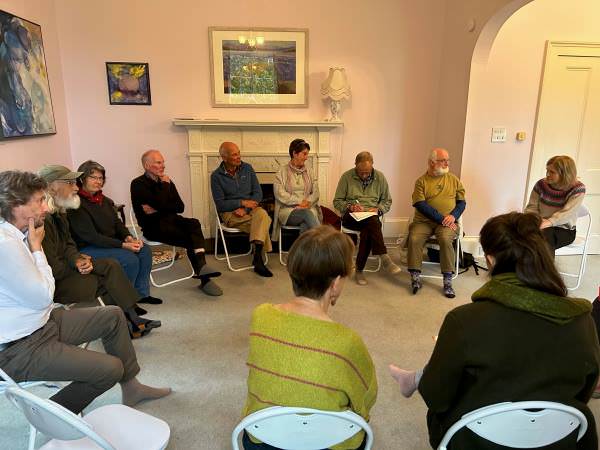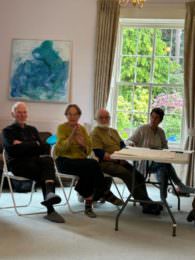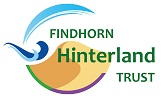As a well trusted and valued organisation within the Park Ecovillage and the Findhorn/Forres area and beyond, the FHT has much to be grateful for and proud of – its work concerning local practical conservation, opportunities for environmental education, helping build local community and providing recreational resources on the land it manages goes from strength to strength. And yet we also need to make sure that what the charity does can carry on well into the future, delivering for the local community and the land it looks after. That is why fourteen of the core team including FHT trustees got together recently in the Cullerne House meeting room with consultants Karen and Kate from the government funded organisation Just Enterprise to look at where we are and what changes need to start to be made to ensure long term sustainability. What follows is their full report.

After reading it, if you are inspired to get involved in any way with our dynamic team and its work and help with this transition, do get in touch.
Jonathan Caddy
FHT Chair
Report from Findhorn Hinterland Trust Strategic Planning Session
22nd May 2024
Background
The Findhorn Hinterland Trust (FHT) has a strong history of volunteerism and has fulfilled its charitable purposes effectively over the past eight years, building on the groundwork of the Findhorn Hinterland Group. However, to ensure sustainability and resilience for the future, FHT needs to undergo significant organisational changes.
Key reasons for change include:
- Stepping down of the current Chairperson: Jonathan has indicated that he wants to step down. He currently gives 35 hours and more to the Trust each week voluntarily.
- Transition from land manager to landowner: FHT is acquiring the land it has managed.
- FHT has a legal duty as the burial authority of the green burial site it operates to maintain the area one hundred years after the last burial
- Conservation work is in habitats that will require ongoing management into the foreseeable future.
As FHT prepares for these transitions, a strategy session was conducted to discuss the organisation’s future path. This session involved trustees, staff and volunteers.
Survey Results and Critical Issues.
Before the strategy session, trustees, staff and volunteers were asked to complete an online survey.
From the results and additional background research, we found that what FHT does is good, timely and relevant. However, a lot of what the organisation does pivots around Jonathan and while this is one of the organisation’s key strengths, it is also its biggest weakness. As the founder, Jonathan and FHT are inextricably linked. This is coupled with the difficulties the Trust faces to attract younger people to get involved in the organisation. Although income covers the current core costs, it would be insufficient to cover the salary of an operations manager.
Although Jonathan doesn’t intend to step down as Chair until January 2026 the Trust should begin planning for this because successful transitions often take several years to plan. It is also important that trustees understand that, currently, Jonathan effectively wears two hats. One as the Chair and the other as the main volunteer often giving 35 hours or more a week to the Trust.
SWOT analysis results
During the strategy session, attendees were asked to look at the following key areas of activity of the charity and consider the key strengths, weaknesses, opportunities, and threats of each, taking into consideration the 4 key reasons for change.
- Conservation
- Education
- community building
- providing recreational opportunities
| Strengths |
Weaknesses |
- Expertise – age, experience, knowledge, depth and breadth of skills-
| Education
Forestry
Ecology
Practical skills
Book-keeping
Finance |
Organisational management
Photography
Local councillor
Marketing
Lichens
Conservation |
- Continuity
- Passion and vision
- Uniqueness of location
- Connection with the eco-village and the people it attracts
- Diverse sources of income
- Practical application of global issues
- Involved in green issues which are topical
- Internal source of income that covers basic expenses
- People enjoy what we do
|
- Ageing demographics
- Diluted energy – complex diverse functions
- Lower population density – fewer volunteers
- Foundation identification- less local support
- Reliance on small group of people
- No specialist fund raiser
- Not enough music festivals!
- Lack of connection to university level organisations
|
| Opportunities |
Threats |
- Increased visitors – means increased education/interest/revenue
- Age demographic changes
- Intergenerational events
- Connect with other groups to raise awareness
- Use social media more effectively – e.g. use younger groups to post videos etc
- Eco theatre
- Culture change
- Outreach to bring in new members/new energy
- Whisky industry
- Green burials
- Glasgow School of Art
- Moray Council courses
- Scottish School of Forestry
- Increased local awareness
- Cooperation with Dunes Trust
- Becoming landowners
- Contact with local groups/schools
- Funding opportunities (as yet unexplored/exploited)
- Nature networks – eg. CAN, TSI Moray
- Tourism levy – potential income
- Visitor income
- Connected member networks
|
- Ageing of trustees and land manager
- Insular
- Sea level rise
- Losing expertise
- Increased number of unaware visitors
- Demographic changes – falling number of young people
- Many things held by one person
|
The SWOT analysis highlights significant strengths in that the work the Trust is involved in is very topical as well as the expertise and passion of those involved. However, it also identifies critical weaknesses such as an ageing volunteer base and diluted organisational focus. Opportunities exist in engagement and partnerships, which could help expand its influence and operations. Threats include the sustainability of leadership and environmental challenges, as well as the operational risks associated with dependency on a small group of key individuals.
Strategy development
 The group consensus, supported by survey results, suggests that the strategy for the next three years should concentrate on continuing what the organisation does at the moment and doing it well, rather than constantly pursuing new projects and expansion. This approach emphasises strengthening the organisation’s core competencies and maintaining the quality of its existing initiatives.
The group consensus, supported by survey results, suggests that the strategy for the next three years should concentrate on continuing what the organisation does at the moment and doing it well, rather than constantly pursuing new projects and expansion. This approach emphasises strengthening the organisation’s core competencies and maintaining the quality of its existing initiatives.
A key component of this strategy involves managing the transition as Jonathan plans to step back from his dual roles as both Chair and the primary volunteer. To ensure a smooth transition, it is crucial for Jonathan and the trustees to clearly distinguish the capacities in which he serves at any given time.
To facilitate role clarity and delegation, the board’s governance policies should clearly state to whom the board delegates management or operations.
If operational tasks are delegated to staff, detailed job descriptions should define the scope and boundaries of their roles. For subgroups taking on specific responsibilities, the board should establish clear terms of reference. These terms might outline the subgroup’s responsibilities, meeting frequency, reporting obligations, minimum volunteer numbers, and leadership roles.
When tasks are assigned to individual board members or other volunteers, the board should establish comprehensive volunteer roles and responsibilities for each type of task.
Having written guidelines that clearly separate governance from operations will aid in this transition, ensuring that everyone involved has a shared understanding of their roles and responsibilities. This structure not only supports the current needs of the FHT but also prepares the organisation for future leadership and operational changes.
Action Plan
The session attendees agreed on the following actions. The next step is to decide who is responsible for implementing each action and when it should be completed.
| TASK |
| Promote green burial – this is the main way to generate unrestricted income for the Trust |
| Terms of reference for subgroups |
| Set out as policy that core costs are funded by income and other activities are funded by grants |
| Look at the list of tasks that Jonathan does – colour code – high/medium/low priority and the number of hours it takes to do each task. What ones can be stopped, delegated to someone else or needs to be part of a paid post. Distinguish between the responsibilities that belong to the Chair and those that are operational |
| Identify what wider policies the Trust needs or already has and may require updating. |
| Secretary has indicated that she also wants to step down – consider how this might be made possible including timescales. |
| Put energy into the group – do more things together |
| Look further afield for volunteers |
Karen Maclean-Yuille
Consultant
Impact Hub, Inverness

















Exploring FHT Sustainability and Resilience
As a well trusted and valued organisation within the Park Ecovillage and the Findhorn/Forres area and beyond, the FHT has much to be grateful for and proud of – its work concerning local practical conservation, opportunities for environmental education, helping build local community and providing recreational resources on the land it manages goes from strength to strength. And yet we also need to make sure that what the charity does can carry on well into the future, delivering for the local community and the land it looks after. That is why fourteen of the core team including FHT trustees got together recently in the Cullerne House meeting room with consultants Karen and Kate from the government funded organisation Just Enterprise to look at where we are and what changes need to start to be made to ensure long term sustainability. What follows is their full report.
After reading it, if you are inspired to get involved in any way with our dynamic team and its work and help with this transition, do get in touch.
Jonathan Caddy
FHT Chair
Report from Findhorn Hinterland Trust Strategic Planning Session
22nd May 2024
Background
The Findhorn Hinterland Trust (FHT) has a strong history of volunteerism and has fulfilled its charitable purposes effectively over the past eight years, building on the groundwork of the Findhorn Hinterland Group. However, to ensure sustainability and resilience for the future, FHT needs to undergo significant organisational changes.
Key reasons for change include:
As FHT prepares for these transitions, a strategy session was conducted to discuss the organisation’s future path. This session involved trustees, staff and volunteers.
Survey Results and Critical Issues.
Before the strategy session, trustees, staff and volunteers were asked to complete an online survey.
From the results and additional background research, we found that what FHT does is good, timely and relevant. However, a lot of what the organisation does pivots around Jonathan and while this is one of the organisation’s key strengths, it is also its biggest weakness. As the founder, Jonathan and FHT are inextricably linked. This is coupled with the difficulties the Trust faces to attract younger people to get involved in the organisation. Although income covers the current core costs, it would be insufficient to cover the salary of an operations manager.
Although Jonathan doesn’t intend to step down as Chair until January 2026 the Trust should begin planning for this because successful transitions often take several years to plan. It is also important that trustees understand that, currently, Jonathan effectively wears two hats. One as the Chair and the other as the main volunteer often giving 35 hours or more a week to the Trust.
SWOT analysis results
During the strategy session, attendees were asked to look at the following key areas of activity of the charity and consider the key strengths, weaknesses, opportunities, and threats of each, taking into consideration the 4 key reasons for change.
Forestry
Ecology
Practical skills
Book-keeping
Finance
Photography
Local councillor
Marketing
Lichens
Conservation
The SWOT analysis highlights significant strengths in that the work the Trust is involved in is very topical as well as the expertise and passion of those involved. However, it also identifies critical weaknesses such as an ageing volunteer base and diluted organisational focus. Opportunities exist in engagement and partnerships, which could help expand its influence and operations. Threats include the sustainability of leadership and environmental challenges, as well as the operational risks associated with dependency on a small group of key individuals.
Strategy development
A key component of this strategy involves managing the transition as Jonathan plans to step back from his dual roles as both Chair and the primary volunteer. To ensure a smooth transition, it is crucial for Jonathan and the trustees to clearly distinguish the capacities in which he serves at any given time.
To facilitate role clarity and delegation, the board’s governance policies should clearly state to whom the board delegates management or operations.
If operational tasks are delegated to staff, detailed job descriptions should define the scope and boundaries of their roles. For subgroups taking on specific responsibilities, the board should establish clear terms of reference. These terms might outline the subgroup’s responsibilities, meeting frequency, reporting obligations, minimum volunteer numbers, and leadership roles.
When tasks are assigned to individual board members or other volunteers, the board should establish comprehensive volunteer roles and responsibilities for each type of task.
Having written guidelines that clearly separate governance from operations will aid in this transition, ensuring that everyone involved has a shared understanding of their roles and responsibilities. This structure not only supports the current needs of the FHT but also prepares the organisation for future leadership and operational changes.
Action Plan
The session attendees agreed on the following actions. The next step is to decide who is responsible for implementing each action and when it should be completed.
Karen Maclean-Yuille
Consultant
Impact Hub, Inverness